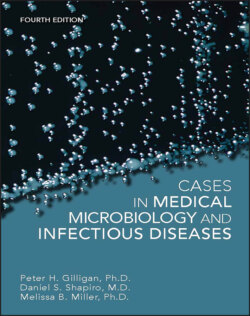Читать книгу Cases in Medical Microbiology and Infectious Diseases - Melissa B. Miller - Страница 21
Staining of acid-fast organisms
ОглавлениеMycobacterium spp., unlike other bacteria, are surrounded by a thick mycolic acid coat. This complex lipid coat makes the cell wall of these bacteria refractory to staining by the dyes used in the Gram stain. As a result, bacteria within this genus usually cannot be visualized or, infrequently, may have a beaded appearance on Gram stain. Certain stains, such as carbol fuchsin or auramine-rhodamine, can form a complex with the mycolic acid. This stain is not washed out of the cell wall by acid-alcohol or weak acid solution, hence the term “acid-fast” bacterium.
Auramine and rhodamine are nonspecific fluorochromes. Fluorochromes are stains that “fluoresce” when excited by light of a specific wavelength. Bacteria that retain these dyes during the acid-fast staining procedure can be visualized with a fluorescent microscope (Fig. 6). In clinical laboratories with access to a fluorescent microscope, the auramine-rhodamine stain is the method of choice because the organisms can be visualized at a lower magnification. By screening at lower magnification, larger areas of the microscope slide can be examined more quickly, making this method more sensitive and easier to perform than acid-fast stains using carbol fuchsin and light microscopy.
Figure 6
Several other organisms are acid-fast, although they typically are not alcohol-fast. As a result, they are stained using a modified acid-fast decolorizing step whereby a weak acid solution is substituted for an alcohol-acid one. This technique is frequently used to distinguish two genera of Gram-positive, branching rods from each other. Nocardia species are acid-fast when the modified acid-fast staining procedure is used, while Actinomyces species are not. Rhodococcus equi is a coccobacillus that may also be positive by modified acid-fast stain when first isolated. The modified acid-fast stain has also been effective in the detection of two gastrointestinal protozoan parasites, Cryptosporidium and Cyclospora. It should be noted that Cyclospora stains inconsistently, with some organisms giving a beaded appearance while others do not retain the stain at all.
